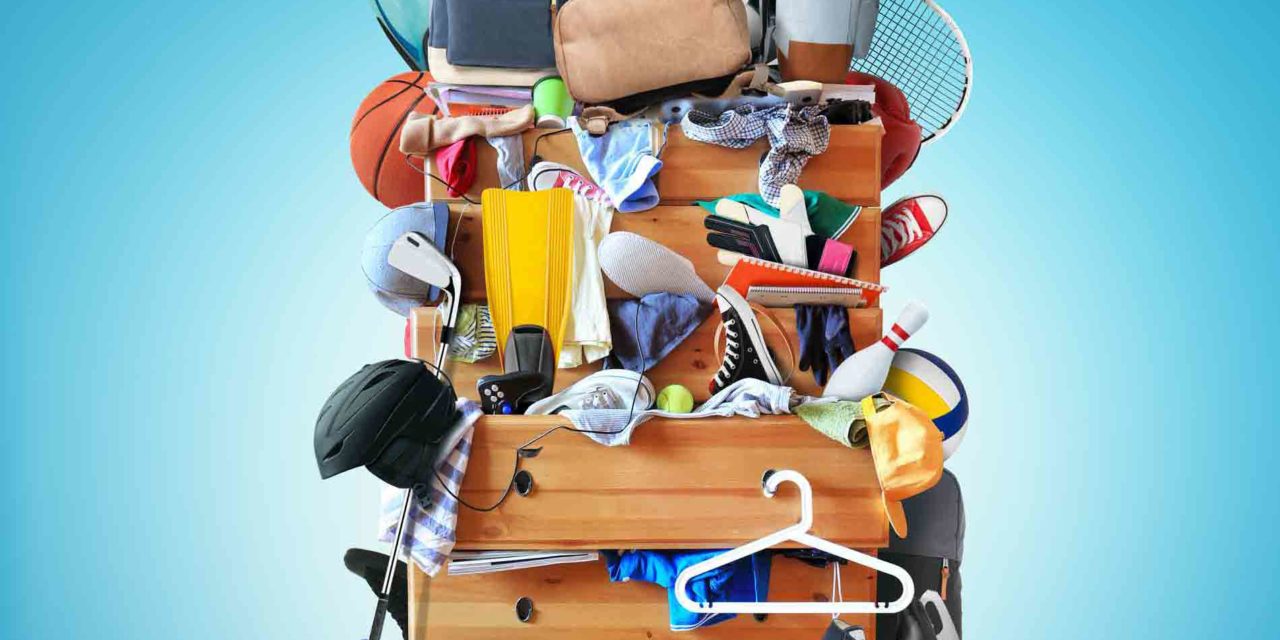by Heather Morris
Clutter happens. It just does.
Even with all of technology’s offerings, it just seems we cannot escape the build-up of stuff. And if you have kids, forget about it. But regardless of age or how many people are in the house, the sheer volume of stuff we accumulate just doesn’t seem to stop growing.
So what do we do when the clutter gets the best of us? How do we tackle the home offices, garages, and basements that have gotten out of control?
Clearing clutter, especially large amounts, can be an emotionally charged exercise. Gretchen Rubin, author of Outer Order, Inner Calm, suggests that with the right mindset going in and some helpful tips to use along the way, the process of getting our outer environments and space in order can create more room for inner peace and happiness in our lives.
PREPARE:
Before you even begin, take the necessary steps to prepare so that you save time and energy, and minimize unneeded stress.
- Identify the “Why.” Rubin warns that without an emotionally strong reason for wanting to clean up, you are likely to lose steam and not be emotionally committed enough to finish what you start.
- Gather the tools. Come in armed and ready with scissors, tape, labels, bins, trash bags, and cleaning supplies so you don’t have to run out in the middle of your cleanup.
- Know where it goes. Before you even know what is going, know where it is going. Make a list of organizations and/or people that will take your donations. (for example, family members who will take your kids’ hand-me-downs or animal shelters that will take your old towels and blankets — and find out the hours and locations of your local landfill and recycling center).
GET RID OF IT:
“Don’t get organized, get rid of it!” Rubin notes that if you get rid of it, you don’t have to organize it at all. You can create order later.
- “Get rid of it” doesn’t necessarily mean throw it away. Local professional organizer Margaret Shipley of Stress Less Organizing, shared her favorite tip: Grab four bins: one for donations, one for trash, one for items to keep and one for items that don’t belong in that room.
- Start with the hidden spaces, not the open spaces. The hidden spaces are where we keep the things that we don’t use. Start in the back of your closet, under the sink, or in a drawer.
- “Do I need it? Do I love it? Do I use it?” If not, let it go.
- Limit the sentimentality. Avoid hanging onto large sentimental pieces like furniture, and opt for the keepsake that fits in the palm of your hand.
- Take a picture. Instead of keeping every outfit your child ever wore, keep a few, take pictures of the rest and give them away.
- Get rid of multiples. Get rid of the duplicates (shampoo, kitchen utensils, coffee mugs!) and only buy it when you need it.
- Ask yourself, “If I didn’t already own it, would I buy this?”
- If the answer is no, toss it.
- If it doesn’t fit, let go of it! It’s that simple.
- Let go of past identities. If you were an avid bike rider 20 years ago and your bike has been gathering dust for years, get rid of it.
CREATE ORDER:
- Organize by theme. Books, sweaters, record collections, cleaning supplies, shoes.
- Start with one theme and move through each, one at a time.
- Be cautious of over-organizing. Books don’t need to be alphabetized, sweaters and towels don’t need to be color-coordinated, and not everything needs a label.
- Leave open spaces. Every surface does not to be filled.
- Use trays. Trays help display items in an organized, contained and visually appealing way.
DEVELOP NEW HABITS:
“It’s easier to keep up than catch up,” Rubin notes. Once you are organized and clutter-free, keep up with small, manageable tasks every day to stop you from having to play catch-up later.
- Only touch it once. Don’t put it down to deal with later — put it away now.
- Create a night-time routine. Take 10 minutes each night to go room by room and put things back where they belong.
- Borrow instead of buy. Borrow books from the library instead of buying them and adding more clutter to your home. Borrow a kitchen gadget from a neighbor if you only need it once.
- One for one. For every item you buy, get rid of one item.
- Buy experiences, not things. Tickets to events, memberships, classes, and massages don’t take up space.
- Can technology replace it? Scan documents, keep digital photo albums, rent movies online.
- Don’t buy it in the first place! Get out of the habit of buying just for the sake of buying. If you don’t need it, don’t buy it.
PLACES TO DONATE:
The Addiction Healing Center
658 Lucabaugh Mill Rd., Westminster • addictionhealingctr.org
Formerly The Rescue Mission. Accepts gently used furniture, clothing and shoes.
Goodwill Industries
200 Baltimore Blvd., Westminster; 1346 Liberty Rd, Eldersburg; 721 Hanover Pike, Hampstead • gimv.org
Accepts books, household items, small furniture and electricals, DVDs/CDs/records/tapes, collectibles, clothing, sheets, towels.
Humane Society of Carroll County
2517 Littlestown Pike, Westminster • hscarroll.org
Accepts towels, pillow cases (no pillows), small blankets, rugs and throws, dish rags.
NESAP Thrift Store
1046 S. Carroll St., Hampstead • www.nesapinc.org
Accepts food, clothing, cleaning supplies
Salvation Army Carroll County
300 Hahn Road, Westminster • 410-876-9358
HSP’s Second Chances Community Free Store
10 Distillery Dr., Westminster • www.hspinc.org/secondchances
Accepts household items, small appliances, decorations, toys, clothing.
The Shepherd’s Staff
30 Carroll St., Westminster • www.shepstaff.org
Accepts new/like-new household items, non-food essentials and personal care items.

